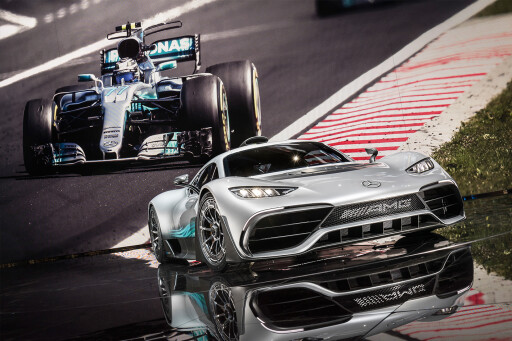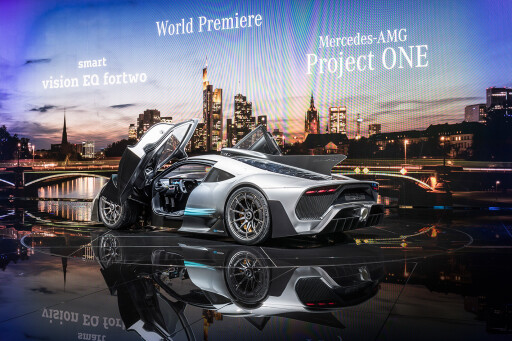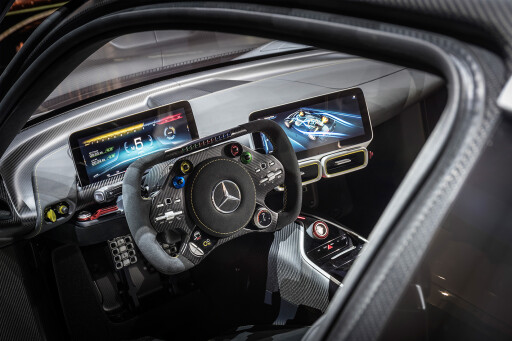
AFTER twelve months of tantalising teasers and a trickle of vital statistics, Mercedes-AMG has finally revealed its knockout punch Project One hypercar, but the tsunami of staggering statistics is only just getting started.
With a 1.6-litre turbocharged Formula 1 V6 at its core, Wheels has learned the maximum power output of “more than 1000 horsepower” (740kW) is closer to 1200hp (895kW) and good for a zero to 200km/h dash in less than six seconds, but no 0-100km/h has been mentioned.
At its reveal at the Frankfurt Motor Show, Mercedes-AMG chief executive Tobias Moers explained that the vicious acceleration enabled by electrified drivetrains will render the traditional zero to 100km/h benchmark irrelevant.
Moers said the Project One could be capable of zero to 100km/h in as little as 2.4 seconds but with a number of vehicles now playing in the ultra-high performance hybrid category, 0-200km/h was more indicative of performance than 0-100km/h where the most potent cars all put in similar times.

“With instant torque you get from an electric motor with the right ratio at the wheels it’s getting closer and more similar,” he said, regarding 0-100km/h times. “I think zero to 200km/h in performance is the new zero to 100km/h.
“It’s important for our customers and for us as well.”
Other extreme car makers are following suit with many now comparing 0-200km/h trumps, including British band Ariel initially releasing only a 0-200km/h figure for its incredible gas-turbine and electric-powered P40 prototype.
Germany’s Nurburgring is increasingly being utilised as another performance car acid test, and while Moers confirmed Affalterbach’s fastest and most powerful road car to date would be hitting the Green Hell, he did not say whether the car could beat the current production car lap record.

“I don’t talk about those numbers. The only number we released is zero to 200km/h.”
When the mighty Merc does roll out for an attempt on the Lamborghini Huracan Performante’s record of 6:52.01 it will call on all of its Formula 1-derived features including the highly-strung engine, extensive lightweight carbonfibre construction and numerous active aero features.
“The front spoiler is movable down and forward. It moves between 80mm and 100mm,” said Moers.
“The (rear) spoiler deploys depending on driving conditions and we have things under the skin as well. The louvres [above the front wheels] are movable as well.”
Owners wanting to use their Project One as a daily drive will need to keep an eye on the mileage, with a full engine rebuild required every 50,000km thanks to its 11,000rpm redline and massive turbo boost pressures, although Moers predicted few Project Ones would clock up such high use.
Even with its massive power output and high maintenance schedule, the Formula 1 V6 is the most thermally efficient engine available in any car, said Moers, with a figure of about 40 percent versus about 35 percent in the next best road car.

“There is no combustion engine available that is more efficient. Knowing that we have a very successful Formula 1 powertrain I thought that it was maybe a good idea to have a hypercar driven by that powertrain.
“There is still a way to go for full electric performance sports vehicles. Hybrid and electrification is going to be the key to performance. It was very clear to us as a team that when we do a kind of hypercar it should be more sophisticated than another V8 or V10 or V12, which would be easily done by us.”
Unlike many other highly desirable and strictly limited high-performance vehicles, Moers said the production run of 275 was not a particularly significant number and simply the volume the factory can produce without making customers wait too long.
“The problem is if you move too high with numbers. In that segment people get tired waiting and of your production time is too long then they get tired.
“If you stretch it too long, in my experience they don’t want it anymore.”
Production is due to start in 2019 with most customers taking delivery the year after.

Of the complete production run, eight examples will be coming Down Under and Moers confirmed that many more could have been sold globally, but the company was not considering boosting total production with special editions.
“For now we are close to four times overbooked with the 275 cars. For now that’s it. I’m not convinced we should do a track only or a spider.”
When asked which cars the development and engineering team used as a benchmark, Moers explained that no rivals currently exist for the Project One and the car had been designed in isolation from any other road car hardware.
“We know the performance figures, we know the weight and power. We talk to customers who own benchmark cars like that, but there is none.”
As for the name, Project One is not yet set in stone but the functioning moniker is the favourite with Moers at this stage.
“Project One sounds cool. One team. Formula 1. Something like that”.



COMMENTS